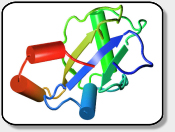The origins of structural biology
Scientists first realised the potential value of understanding the structure of biomolecules over 50 years ago, when Jim Watson, Francis Crick, Maurice Wilkins and Rosalind Franklin (who worked at Birkbeck from 1953-8) discovered the famous double helix of DNA. This laid the foundation for our understanding of the genetic code, and the development of molecular biology and biotechnology. But DNA is only the "instruction manual" for an organism. It is the many kinds of proteins that are encoded by the organism's DNA that perform most of the functions it requires to live.
Structural biology and the human genome
The human genome contains the code for about 30,000 different proteins. We now know the structures of several thousand of them, and can guess those of some others. This gives scientists a unique insight into the workings of the human body in health and disease.
One of the very first structures to be solved, haemoglobin, gave us a picture of how differences in protein structure lead to abnormalities in protein function and then to disease. This is the oxygen-carrying protein that is found in red blood cells. In people with sickle cell anaemia, one simple change in chemical structure on the surface of a haemoglobin molecule creates a "sticky patch" that leads to the haemoglobin molecules forming fibres, causing serious anaemia. This type of protein aggregation is very simple to understand. We are only now beginning to know enough about protein structure to understand how some other proteins can aggregate to cause even more devastating conditions including Huntington's and Alzheimer's diseases.
On completion of the PPS certificate, a student will be able to understand much of the molecular and structural basis of these and many other important biological processes. The complexity underpinning how cells protect themselves from stress and prevent proteins from misfolding, using proteins called chaperones, and molecular mechanisms for bacterial infection, are examples of processes that we highlight. These examples link the PPS coursework to the internationally recognised research of the School of Crystallography via, the work of, respectively, Professor Helen Saibil, FRS and Professor Gabriel Waksman. |

![]() Course overview
Course overview![]() Course details
Course details![]() Syllabus
Syllabus![]() Course fees
Course fees![]() How to apply
How to apply![]() MSc structural biology
MSc structural biology![]() PPS course
PPS course![]() PX course
PX course![]() TSMB course
TSMB course![]() Commonwealth
Commonwealth![]() scholarships
scholarships![]() 2009/10 course access
2009/10 course access![]() 2008/9 course access
2008/9 course access